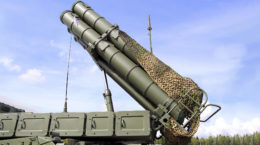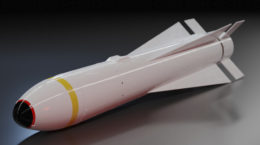Belarus indeed has a long-standing reputation of a supplier of military equipment for the countries of the third world. Those who do not want to fight with machine guns only, but just cannot buy any modern military technology in the West.
On March 17, visiting the Planar holding in Minsk, Aliaksandr Lukashenka speechified about the all the necessary competences that Belarus possessed to satisfy the demands of the Russian market of microelectronic components remaining after the Western companies had left it. At the meeting devoted to the development of microelectronics, he claimed that cooperation between the civil and the defense industry in Belarus create such products as drones, robots, numerically-controlled machine-tools, brand new types of weapons and what not.
However, the real situation, as always, is somewhat different. Real developments of Belarusian gun-makers «took off» in the early 2010s, when military equipment and ammunition deposits had been sold out, and the official Minsk did not want to lose revenues coming from arms trafficking.
In 2012, organizations of the State Authority for Military Industry system completed development and started production of over 35 samples of modern innovative products. In particular, Agat-System OJSC completed development of tactical radio stations Bekas and Rhapsodia and prepared them for production. The JSC KB Display designed helmet-mounted indication systems. The OJSC «Research Institute of Electronic computers» developed and put into production a number of PCs with integrated navigation aids in armored design (worn on a sleeve, pocketable, tablet).
Also, in 2012, five new weapon systems, military and specialized equipment, were introduced into service, including a mobile communication node «Muscat», a mobile radio and television center, a Rosa-RB mobile low-altitude target detection radar and others.
As industry experts testify, the year 2012 was the primary development phase for the holdings of the State Authority for Military Industry, for their management and planning system debugging, approbation of financial and economic arrangements. In the system of the State Authority for Military Industry three sectoral holdings involving technologically and organizationally integrated structures are present:
– Communication and Control Systems;
– Geoinformation Control Systems;
– Radar Systems.
The cooperation of developer and manufacturer in the framework of the Geoinformation Control Systems holding resulted in implementation of the digital automated communications complex Muscat and radio relay stations Citrus, developed by the OJSC «AGAT – Control Systems», into production.
A separate business activity of the Belarusian defense industry in 2012 was development of multifunctional unmanned aerial systems for special purposes, development of military and dual-use radio communications equipment, creation of unified navigation and time support system of the Republic of Belarus.
On February 9, 2013, the USA issued sanctions against two enterprises of the Belarusian defense industry: the companies TM Services (TMS) and KB Radar and their subsidiaries. They were accused of violation of the US Non-Proliferation Act in relation to Iran, North Korea and Syria. According to the US government, actions of the Belarusian structures were capable to contribute to development of weapons of mass destruction or cruise or ballistic missiles there.
In 2012, the Iranian military managed to take control and land the pride of the American army – a top-secret reconnaissance UAV RQ-170, on their territory. For that, they used new Belarusian mobile two-coordinate solid-state radio-Vostok-E radar, manufactured by the JSC «KB Radar», on the chassis МЗКТ-65273-20.
JSC «KB Radar» is the managing company of the Radar Systems holding company, which also includes such companies as JSC Alevkurp and JSC Volatavto.
KB Radar is specialized in development of design documentation, production and maintenance of equipment in the sphere of radar and electronic warfare at all stages of its life cycle, as well as any-level modernization and repair of radar stations and equipment, means of electronic warfare, telemetry and data transfer. The enterprise has a right to conduct export-import operations with the said products and services. The quality management system of the OJSC KB Radar regarding radar and electronic warfare systems is certified to international standard ISO 9001-2001.
After the collapse of the Soviet Union, in the 90s, a specialized aviation field surveillance radar was created at the enterprise on the basis of old Soviet designs, also a number of projects were implemented to modernize old radar stations, and to develop automatic recognition devices for two types of air defense missile systems, modern unified digital signal simulators for a wide variety of radar stations and other. On December 30, 2010, the Design engineering bureau Radar was transformed into an Open Joints Stock Company (OJSC KB Radar), 100% of its shares belong to the state. The number of employees was around 500.
The enterprise develops recognition systems for tracking radar units for different types of air defense systems, surveillance radars and low-altitude surveillance radars, portable ground radar sets and other models of radar equipment.
Also, KB Radar:
– has developed a portable digital solid-state surveillance radar with meter wave range with high tactical and technical characteristics;
– is creating a portable solid-state wireless low-level all-round coverage radar systems with centimeter wave range with radial-ring phased antenna grid;
– has been supplying special interference signal transmitter OPTIMA-2 and complexes OPTIMA-3 for radio suppression of satellite navigation equipment of high-precision weapons;
– has elaborated a mobile radio-frequency source signal recognition and direction complex and got it accepted by the customer for operation. The complex allows to perform automatic search, detection, location and visualization of radio-frequency sources on an electronic map, also in urban conditions;
– developes projects of partial and full modernization of radar P-12, P-18, P-15 and P-19;
– is cooperating with a number of foreign companies for which it is successfully implementing projects in the sphere of radar and radio-electronic warfare.
Already in the year 2013, the Armed Forces of Belarus were equipped with domestic communication and electronic warfare systems, modernized control systems, new navigation survey support equipment. Also, with varying degrees of success, scientific and technical programs of the Union State were launched («Monolit», «Telematic-SG», «ARM-M», «Ballistica»).
Moreover, it was then, when the enterprises of the State Authority for Military Industry of Belarus got the opportunity to compete with Russian military industrial companies on equal terms. It was the Russian government that granted the Belarusian manufacturers to participate in the state defense orders of Russia. The corresponding decree was signed on January 28, 2013, by Dmitry Medvedev, the prime minister at the time.
However, then some real mayhem started. In 2014, Russia began a war against Ukraine by seizing Crimea and eastern territories of Donetsk and Luhansk regions. In response, Ukraine curtailed every military technical cooperation between Ukrainian and Russian enterprises. Then, a critical decision was taken in Moscow: all components for Russian weapons must be produced in the territory of the Russian Federation only, so to say, to avoid new incidents.
That decision had a strong impact on the Belarusian semiconductor and opto-electronic industry: a lot of connections with Russian components buyers got broken and joint projects were stopped. The only thing left to do was to sell the Belarusian military electronics to different cannibalistic regimes in poor faraway countries.
Now, years later, Russia has understood that it cannot go without Belarusian components, as it cannot manage to set up its own production. So, everything comes full circle.
Any reasonable person would ask an obvious question: why Belarusian enterprises do not make microelectronic components for peaceful purposes? Why for weapons only? The answer is simple: time has been lost. In order to do that, the industry and economy should have been reformed as long ago as in the 90s, investments should have been attracted, private property should have been protected. Yet, Aliaksandr Lukashenka preferred to «maintain the Soviet legacy». And now, it’s the only thing we have – Belarusian electronics is good only for tanks, missiles, radars and other murder weapons. Moreover, only for those that had been developed in the times of the USSR.
In the next article we shall explain why Lukashenka is pushing the Belarusian economu on a path of war.










